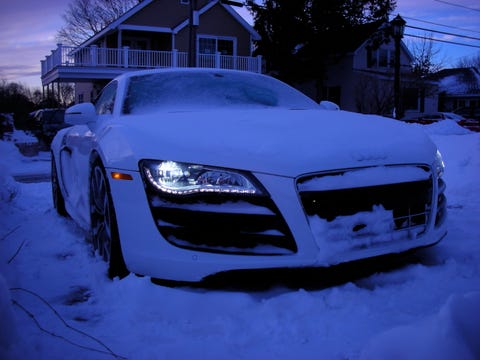In the thick of winter, the common wisdom is that when you are gearing up to take your truck out in the cold and snow, you should step outside, start up your engine, and let it idle to warm up. But contrary to popular belief, this does not prolong the life of your engine; in fact, it decreases it by stripping oil away from the engine's cylinders and pistons.
In a nutshell, an internal combustion engine works by using pistons to compress a mixture of air and vaporized fuel within a cylinder. The compressed mixture is then ignited to create a combustion event—a little controlled explosion that powers the engine.
When your engine is cold, the gasoline is less likely to evaporate and create the correct ratio of air and vaporized fuel for combustion. Engines with electronic fuel injection have sensors that compensate for the cold by pumping more gasoline into the mixture. The engine continues to run rich in this way until it heats up to about 40 degrees Fahrenheit.
"That's a problem because you're actually putting extra fuel into the combustion chamber to make it burn and some of it can get onto the cylinder walls," Stephen Ciatti, a mechanical engineer who specializes in combustion engines at the Argonne National Laboratory, told Business Insider. "Gasoline is an outstanding solvent and it can actually wash oil off the walls if you run it in those cold idle conditions for an extended period of time."
The life of components like piston rings and cylinder liners can be significantly reduced by gasoline washing away the lubricating oil, not to mention the extra fuel that is used while the engine runs rich. Driving your car is the fastest way to warm the engine up to 40 degrees so it switches back to a normal fuel to air ratio. Even though warm air generated by the heater core will flow into the cabin after a few minutes, idling does surprisingly little to warm the actual engine.
The best thing to do is start the car, take a minute to knock the ice off your windows, and get going. The obvious caveat here is that if it's below freezing, you need to make sure your defroster is working before you go tearing out of your driveway. Don't be the person peering through a porthole in your ice-covered windshield. Some cars, like certain Land Rovers, expedite this process with electric heating elements in the windshield.

Ezra Dyer
Also, hopping into your car and gunning it straightaway will put unnecessary strain on your engine. It takes 5 to 15 minutes for your engine to warm up while driving, so take it nice and easy for the first part of your drive. Performance cars often enforce that process with a graduated rev limiter—you don't get full RPM until the engine is up to temperature.
Warming up your car before driving is a leftover practice from a time when carbureted engines dominated the roads. Carburetors mix gasoline and air to make vaporized fuel to run an engine, but they don't have sensors that tweak the amount of gasoline when it's cold out—they use a mechanical system called a "choke" to temporarily restrict the air intake and run a richer mixture.
This is a crude way to adjust the air-fuel ratio, and anyone with a carbureted engine can attest that it's hard to drive under load when the carb is choked. It's easy to stray too rich on the mixture and foul your spark plugs. As a result, you do need to let older cars warm up before driving or they will stall out. But carbureted engines were on their way out by the late 1980s.

Ezra Dyer
We asked Volvo, which conducts cold-weather testing in the Arctic, whether their new cars need any sort of warmup, and the answer was an ever-so-slightly qualified no. According to Volvo, "It’s best to just give the engine a few seconds to build oil pressure before driving normally. Good oil quality and condition are crucial for protecting the engine in cold start conditions."
The Engine Block Heater

Ezra Dyer
If only there were a way to get your car's fluids up to temperature—and thus get the heater and defroster going—before actually starting your car. Well, there is: an engine block heater. Block heaters use an electrical element to preheat your engine's fluids so it's ready to go (and easier to start) when the temperature drops, thus explaining the three-prong plug poking out of the grille of your neighbor's definitely-not-hybrid F250. They're a common option on trucks, with Chevy charging only $100 for a block heater on a new Colorado (gas or diesel), but they can also be retrofitted to just about any vehicle.
Aftermarket block heaters are also inexpensive, and can be well worth the money when you consider the reduced wear and tear (and generally more pleasant mornings) they deliver.
So that's it. Unless you're rolling in a 1970s Chevelle—which we assume isn't your daily driver—bundle up, scrape off your car, and get it moving.
